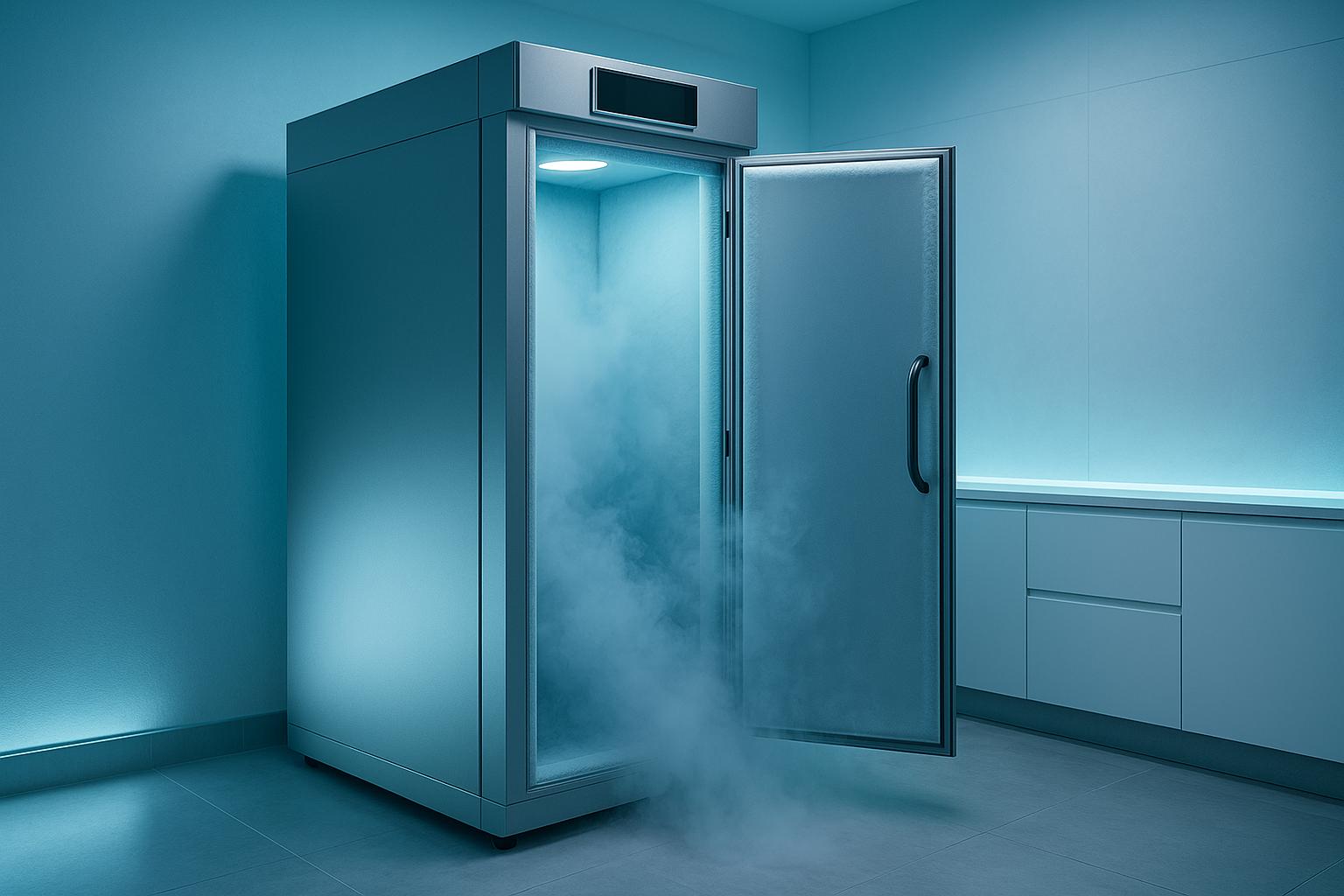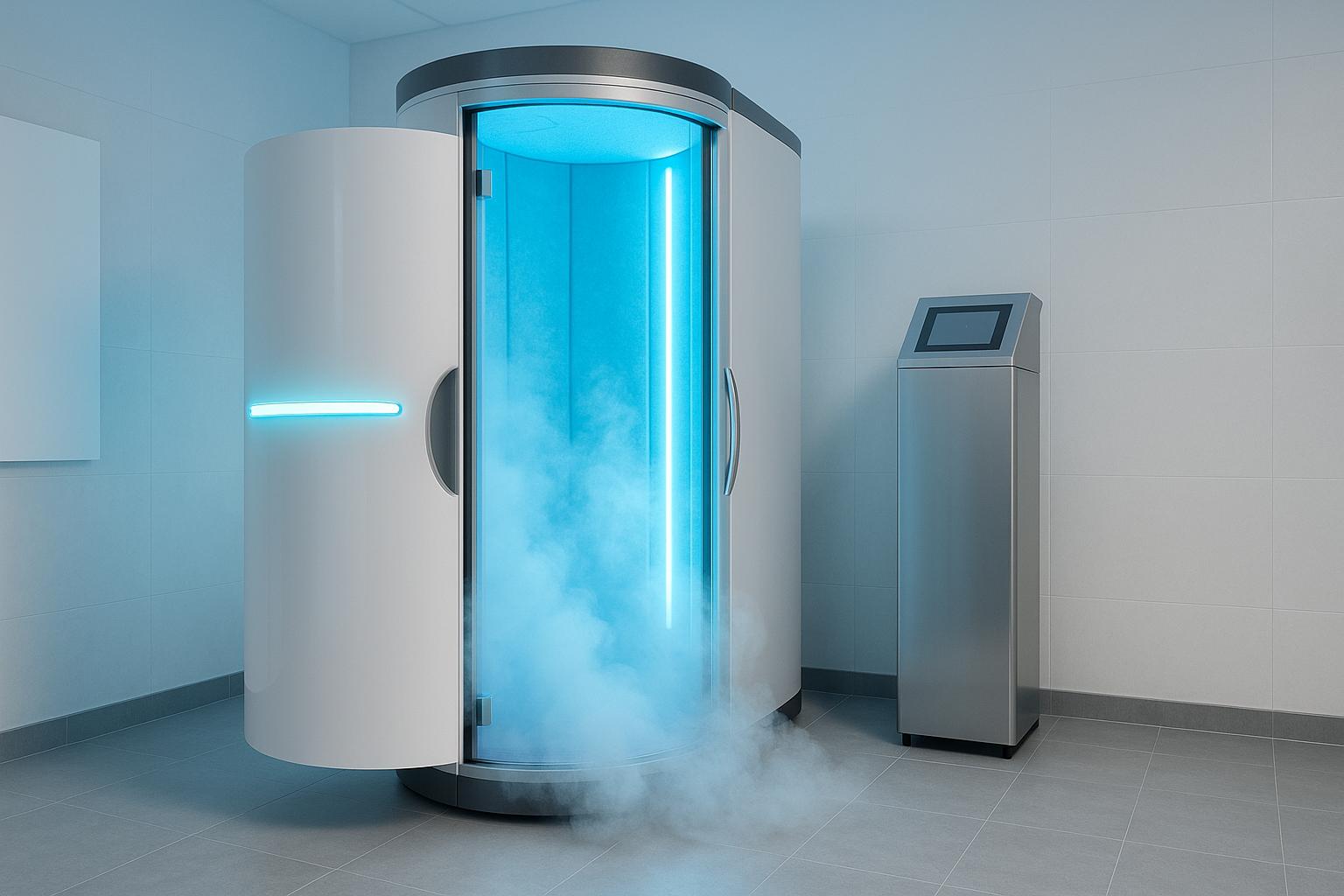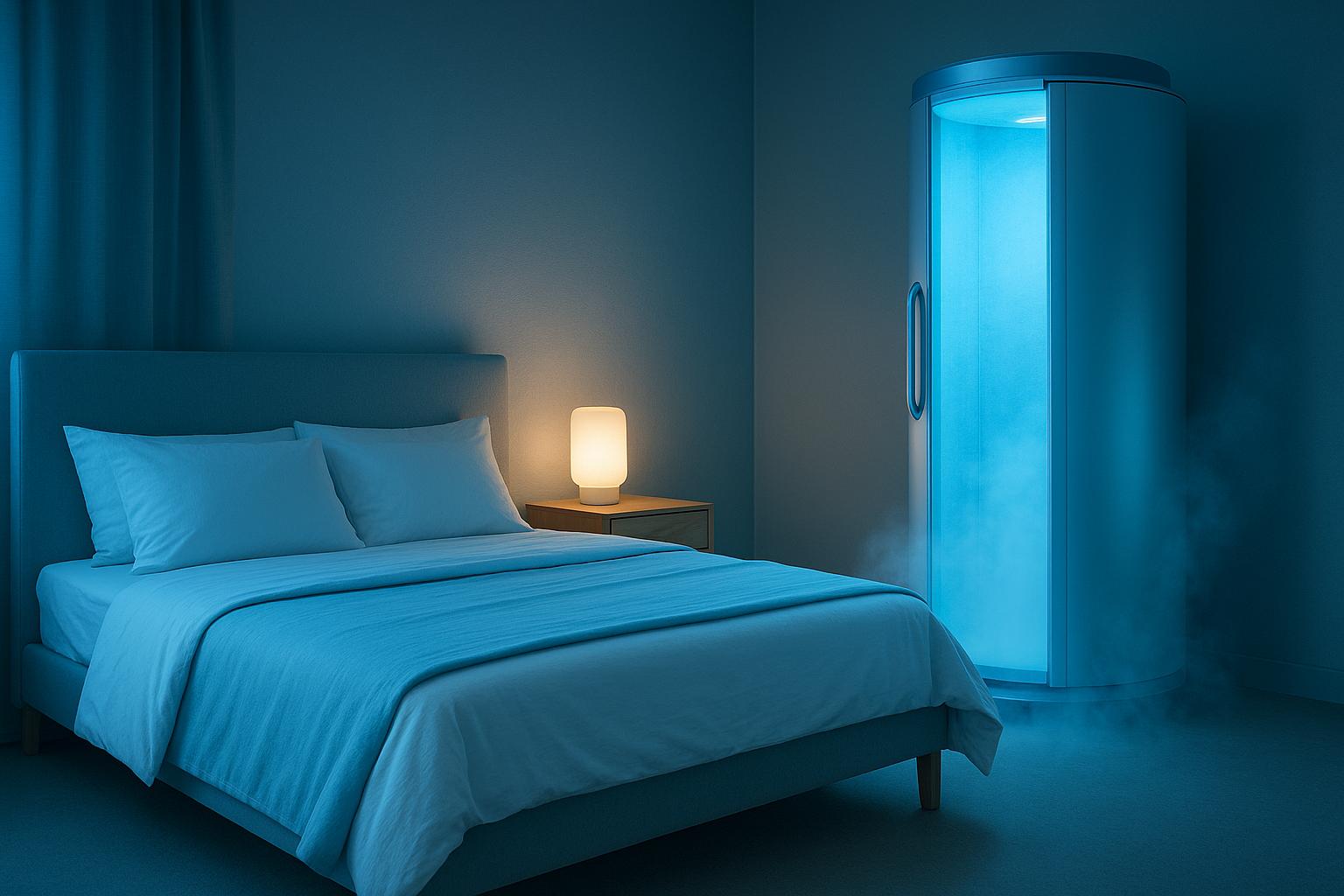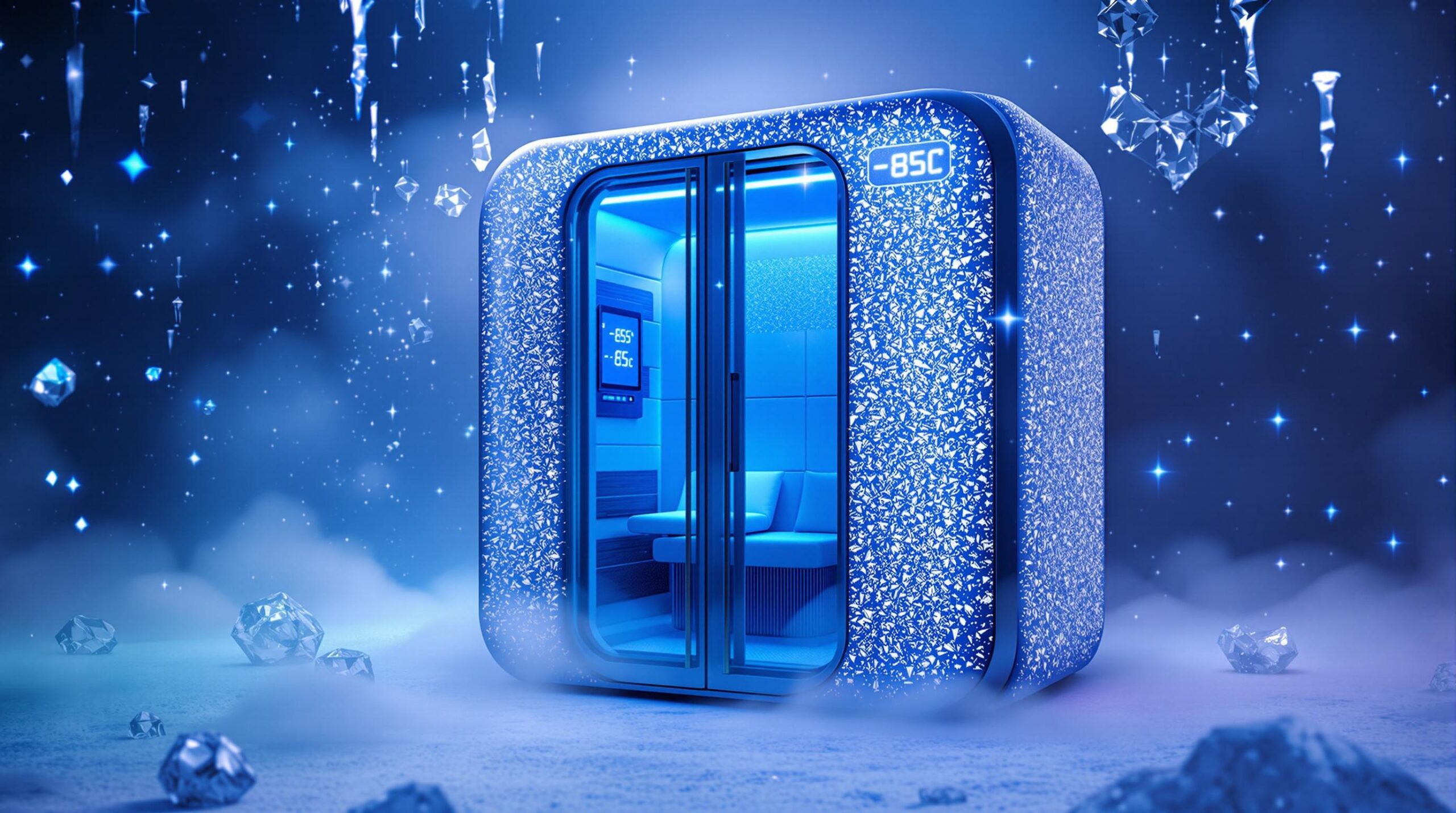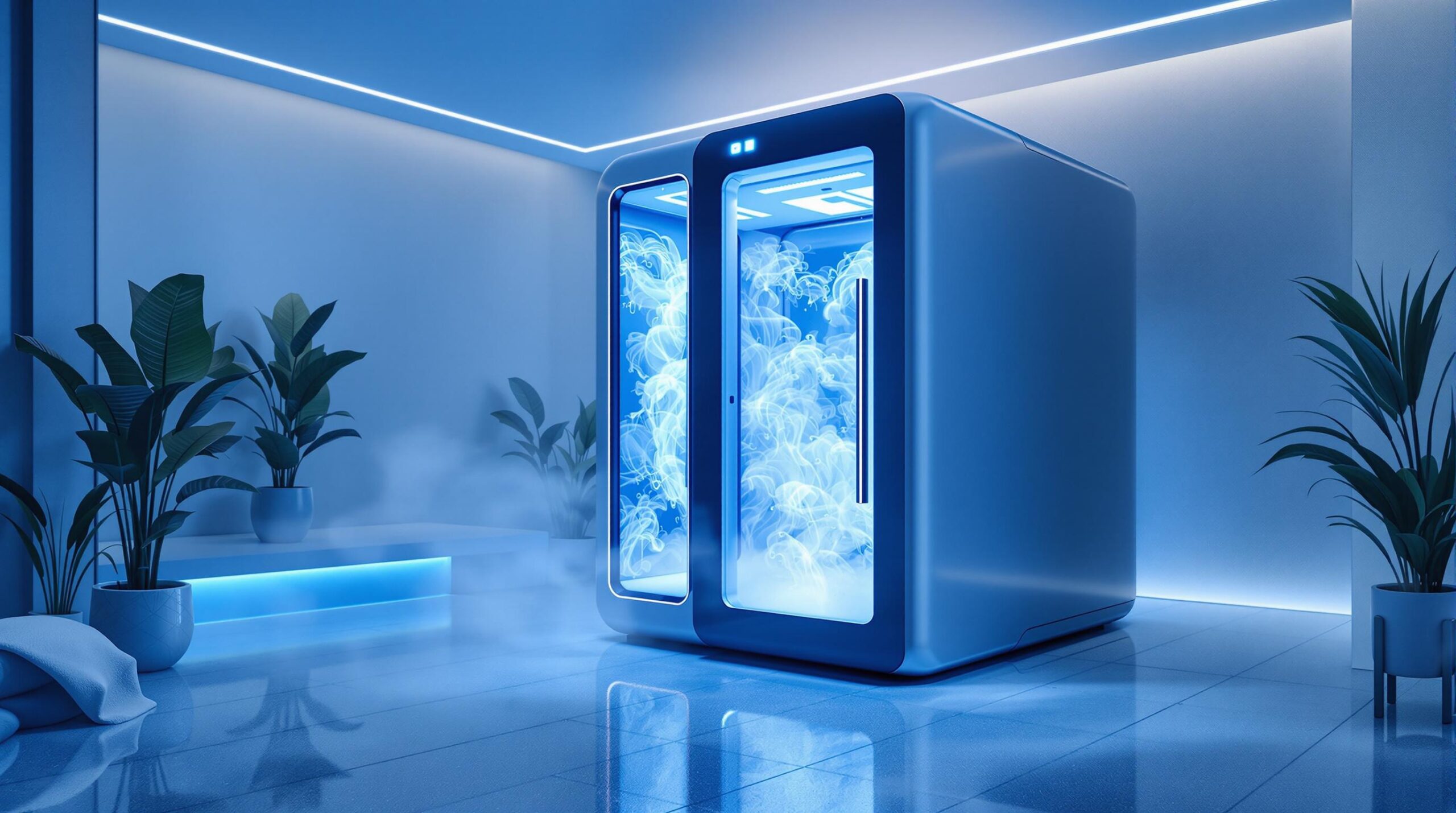Whole Body Cryotherapy (WBC) is a quick, non-invasive treatment where your body is exposed to extreme cold -85°C) for 3-5 minutes. It’s used by athletes for faster recovery, by individuals with chronic pain for relief, and by wellness seekers to improve mood and reduce stress. Here’s what you need to know:
- Benefits: Pain relief, reduced inflammation, better mood, improved circulation, and immune support.
- How It Works: Extreme cold triggers vasoconstriction, endorphin release, and other physiological responses.
- Preparation: Remove metal items, keep skin dry, and wear protective gear (socks, gloves, headband). Facilities provide most items.
- Safety: Not suitable for people with heart conditions, high blood pressure, pregnancy, or other medical restrictions. Always undergo a medical screening.
Quick Tip: Sessions last only 2–3 minutes, and effects like energy boosts or reduced soreness can be felt immediately. Always follow safety guidelines and consult a doctor if unsure.
Does Whole Body Cryotherapy Actually Work?
Before Your First Session
Getting ready for cryotherapy? Here’s how to prepare for a safe and smooth experience. Follow these steps to ensure you’re fully prepared.
What You Need to Do
Before stepping into the chamber, take off all jewelry, watches, and metal accessories – they can get dangerously cold. Make sure your skin is completely dry and free of any lotions, oils, or moisturizers.
| Required Items | Provided by Facility | Bring Yourself |
|---|---|---|
| Protective Socks | ✓ | Optional |
| Gloves | ✓ | – |
| Headband/Earmuffs | ✓ | – |
| Cotton Shorts | – | ✓ |
| Sports Bra (for women) | – | ✓ |
For clothing, men should wear cotton shorts and underwear. Women can choose shorts with a sports bra or a swimsuit. The facility will supply protective gear like thermal socks, gloves, and sometimes headbands or earmuffs to shield sensitive areas from the intense cold.
Medical Screening
A medical screening is mandatory to check for any risks. During this process, a technician will:
- Review your medical history.
- Look for conditions like heart issues or high blood pressure.
- Confirm you’re not pregnant and are at least 18 years old.
- Evaluate your skin for sensitivities or conditions.
Health Conditions That May Restrict Participation:
- Uncontrolled high blood pressure
- Heart problems
- Neurological disorders
- Pregnancy
If you have any health concerns, consult your doctor beforehand. Some facilities might ask for written clearance if you have specific medical conditions. This screening ensures your cryotherapy session is as safe as possible.
During Your Session
Time and Equipment
Whole Body Cryotherapy sessions are quick, lasting only 3-5 minutes. This short duration ensures safety while still providing therapeutic effects. During your session, you’ll step into one of two types of chambers:
- Cryosauna: A vertical chamber for one person, where your head stays outside.
- Cryochamber: A larger, multi-person chamber that fully encloses your body, including your head.
Inside, temperatures can plummet to as low as (-85°C). Trained technicians will closely monitor both the temperature and your reactions throughout the session. Now, let’s talk about what you’ll experience during the treatment.
What You’ll Feel
When you first step in, you’ll feel an intense wave of cold – completely normal! Your technician will guide you to breathe deeply and steadily to help ease the initial shock.
As the session continues, you might notice tingling, slight numbness, and a natural urge to shift around. To ensure even exposure, here are a few tips:
-
Rotate every 10–15 seconds
. - Take deep, steady breaths throughout.
- Shift your weight lightly.
The extreme cold triggers your body’s fight-or-flight response, which can leave you feeling energized. Afterward, your skin may look a bit red, but don’t worry – this usually fades within minutes.
sbb-itb-32603e3
Results and Recovery
Physical Effects
After a cryotherapy session, you might notice a boost in energy and mood, thanks to a rush of endorphins. Your skin may feel cold and appear slightly red, but these effects usually fade within minutes.
Cryotherapy offers both quick and lasting effects. Some people feel immediate relief from pain or reduced inflammation, particularly if they deal with arthritis or muscle soreness. Over time, regular sessions can lead to better skin tone and texture due to improved blood flow.
| Timeframe | Expected Effects |
|---|---|
| Immediate (0-30 mins) | • Skin redness • Endorphin boost • Increased energy • Initial pain relief |
| Short-term (1-24 hrs) | • Reduced inflammation • Better mood |
| Long-term (with regular sessions) | • Ongoing pain relief • Healthier skin • Boosted metabolism • Improved immune response • Weight loss |
To get the most out of your session, follow these recovery tips.
After-Session Care
Taking care of yourself after cryotherapy can help maximize the benefits. Drink plenty of water to stay hydrated and aid your recovery. Pay attention to how your body feels throughout the day. While many people feel energized and ready to jump back into their routine, some might need a little extra time to adjust.
Here are some helpful tips:
- Keep an eye on your energy levels, pain, and skin sensitivity.
- Avoid extreme temperature changes, like very hot showers or ice baths, right after your session.
- Listen to your body – if you feel unusually tired, take some time to rest.
For the best experience, work with your cryotherapy technician to create a treatment plan tailored to your needs.
Safety Guidelines
Possible Risks
It’s important to be aware of the risks associated with cryotherapy to ensure safe use. Common side effects include temporary skin redness and mild irritation, which usually go away within a few hours. However, more serious issues can arise if safety protocols aren’t followed.
| Risk Level | Potential Issues | Prevention Measures |
|---|---|---|
| Minor | • Skin redness • Mild skin irritation |
• Use proper protective gear • Stick to recommended time limits • Monitor temperatures regularly |
| Serious | • Frostbite • Cold burns • Allergic reactions |
• Conduct pre-screening consultations • Ensure supervision by certified staff • Have emergency protocols ready |
To reduce risks, always stick to session limits and wear the required protective gear. Sessions should never exceed 2–3 minutes, as longer exposure can lead to cold-related injuries. Following these guidelines is key to staying safe.
Health Restrictions
Certain medical conditions may make cryotherapy unsafe. Always consult your healthcare provider if you have any of the following:
| Medical Condition | Risk Factor |
|---|---|
| Hypertension | Cold exposure can influence blood pressure |
| Heart Disease | Extreme cold may put stress on the heart |
| Pregnancy | Cryotherapy could pose risks to the fetus |
| Seizure Disorders | Cold exposure might trigger seizures |
| Anemia | Reduced blood circulation can heighten cold sensitivity |
| Claustrophobia | The enclosed chamber may cause anxiety |
During the session, trained staff should monitor you closely and check temperatures regularly. The facility must be equipped with emergency procedures, including a shut-off button and proper ventilation systems.
Staying hydrated can help your body handle the cold better. If you feel any unusual discomfort, notify your technician right away – they are trained to address concerns immediately. These precautions, along with proper preparation, contribute to a safe and controlled cryotherapy experience.
Making Your Decision
When deciding on cryotherapy, it’s essential to weigh several key factors. Use the table below to guide your evaluation:
| Decision Factor | What to Consider | Action Steps |
|---|---|---|
| Health Goals | – Pain management needs – Recovery requirements – Wellness objectives |
– Document current symptoms – Set measurable targets – Track progress consistently |
| Medical Status | – Existing conditions – Current medications – Recent injuries |
– Complete a medical screening – Consult a healthcare provider – Review any contraindications |
| Logistical Factors | – Session costs – Facility location – Time commitment |
– Compare pricing options – Research certified facilities – Plan session frequency around your schedule |
Take the time to carefully assess these factors before committing to a facility. Look for locations that are certified, equipped with modern technology for precise temperature control, and have clear emergency protocols.
Cost is another consideration. Compare pricing options and try a trial session first to ensure it meets your expectations. Keep track of your progress by noting recovery times, and observing changes in energy, sleep quality, and mood.
Think about how cryotherapy fits into your broader wellness routine. Many people combine cryotherapy with regular exercise, balanced nutrition, proper hydration, good sleep habits, and stress management techniques to enhance the overall benefits.
Stay cautious of facilities that lack certified staff, skip medical screenings, or make exaggerated claims about results. A reputable facility will prioritize safety and transparency.
Ultimately, your decision should align with your health goals, safety standards, and practical needs. Research thoroughly, ask plenty of questions, and ensure you feel confident and comfortable before starting your first session.
FAQs
Here are quick answers to some common questions to help you prepare for your cryotherapy session.
What happens during your first cryotherapy session?
Your first session starts with a quick consultation to ensure you’re eligible. After that, you’ll step into the cryochamber for a 3-5 minute session at temperatures as low as -85°C. During this time, you might experience a strong chill, tingling sensations, or numbness. A technician will monitor you closely, guiding you to stay calm, breathe deeply, and move gently to keep blood flowing properly.
What should you wear for cryotherapy?
Minimal clothing is recommended to allow maximum skin exposure. Facilities usually provide protective items like gloves and socks. Men typically wear shorts, while women wear shorts with a sports bra or tank top. Check the preparation guidelines for a full list of what you’ll need and what’s provided.
Important: Remove all jewelry, watches, and any metal objects before entering the cryochamber. Also, ensure your skin is completely dry to avoid ice formation during the session.

